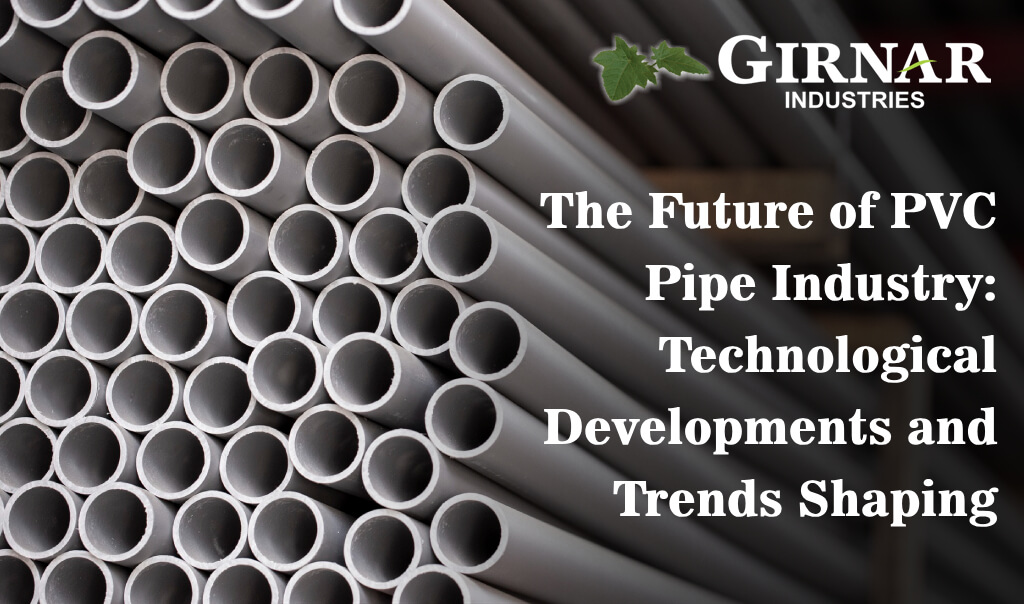The PVC pipe business, known for its adaptability and durability, has played an essential role in various industries, including construction, agriculture, and infrastructure development. Over time, technological improvements and altering market demands have accelerated the evolution of PVC pipes, reshaping the industry environment. This blog will look into the technologies and trends shaping the future of the PVC pipe business.
Technological Developments Enhancing PVC Pipes
Advanced Formulations: Manufacturers are constantly improving PVC formulations, optimizing them for increased strength, flexibility, and resistance to environmental conditions. Innovations in additives and chemical compositions have resulted in pipes tolerating higher pressure and temperatures.
Smart Pipe Technology: Installing sensors and monitoring devices to PVC pipes has transformed maintenance and management. Innovative PVC pipes with IoT technology allow for real-time water flow, pressure, and temperature monitoring, aiding in the early discovery of leaks or potential issues.
Nano-Enhanced Materials: The use of nanotechnology resulted in PVC pipes with enhanced qualities. Nano-additives reinforce pipes, increase corrosion resistance, and expand their lifespan, leading to more sustainable and lasting infrastructure.
Trends Shaping the PVC Pipe Industry
Sustainability: With a growing focus on sustainability, the PVC pipe business is adopting environmentally friendly techniques. Recycled PVC materials and environmentally conscious production processes are gaining appeal, coordinating with global aspirations to achieve a circular economy.
Biodegradable PVC: Experts and makers are looking at biodegradable alternatives to typical PVC to create pipes that are both functional and environmentally benign, as well as easily degradable after usage.
Shift Towards Modular Systems: Demand for modular pipe systems is increasing, driven by the need for construction and installation flexibility. PVC pipes that join readily in modular designs are efficient and adaptable, meeting various project requirements.
More Blogs:- groundnut oil benefits , POLYPROPELENE
Market Influences Reshaping PVC Pipe Usage
Infrastructure Development: Rapid growth in cities and infrastructure projects worldwide increases the demand for dependable and cost-effective pipe systems. PVC pipes, noted for their low cost and versatility, are becoming used in these developments.
Water Management and Conservation: Growing worries about water shortages and the need for effective water management systems drive up demand for quality PVC pipes in irrigation, drainage, and water distribution systems.
Renewable Energy Expansion: The developing renewable energy sector, which includes solar and wind power, relies on PVC pipes for a variety of applications involving cable protection and duct systems, which helps to drive industry growth.
Challenges and Opportunities Ahead
Despite optimistic developments, the PVC pipe sector addresses the following challenges:
Regulatory and Environmental Concerns: Regulations regarding plastic use and environmental impact present barriers for PVC manufacturers. Addressing these challenges necessitates innovation in recycling processes and sustainable material sourcing.
Competitive Market Dynamics: Intense competition in the plumbing sector drives makers to differentiate their solutions through innovation, quality, and cost-effectiveness.
However, these challenges present growth opportunities:
Innovation Drive: The requirement to comply with regulations and meet consumer demand fuels innovation. Companies investing in research and development for eco-friendly, high-performance PVC pipes get a competitive advantage.
Collaboration and Partnerships: Collaborations among industry participants, academic institutes, and governments encourage technological developments and solutions for sustainable PVC pipe production and use.
Conclusion
Technological advancements, sustainability initiatives, and changing market expectations are driving a transition in the PVC pipe sector. As the industry experiences challenges, there are numerous opportunities for companies committed to innovation, sustainability, and satisfying the diversified needs of the construction, infrastructure, and water management sectors. The future of PVC pipes lies in combining technology, sustainability, and adaptation, providing a resilient and robust industry for years.
FAQ’S
How big is the PVC pipe industry?
The PVC pipe industry holds a substantial global presence, valued at billions of dollars. Its size continues to expand due to widespread applications in construction, water supply, irrigation, and industrial sectors. With a steady demand driven by infrastructure development worldwide, the industry's annual growth rate remains significant.
Which is better PVC or CPVC?
When comparing PVC (Polyvinyl Chloride) and CPVC (Chlorinated Polyvinyl Chloride), it's important to consider the application. PVC is suitable for water supply, drainage, and irrigation systems, while CPVC is ideal for hot water distribution due to its higher temperature resistance. CPVC also exhibits better chemical resistance
Does PVC have a waterproof coating?
Yes, PVC (Polyvinyl chloride) is waterproof. PVC pipes and fittings are widely used in plumbing, irrigation, and construction due to their waterproof properties. The material is non-reactive with water and resistant to corrosion, making it an excellent choice for applications requiring waterproofing. PVC's waterproof nature makes it suitable for a variety of uses, including drainage systems, water supply lines, and underground piping.
Where is PVC mostly used?
PVC (Polyvinyl chloride) is predominantly used in various industries, including construction, plumbing, and electrical. In the construction industry, PVC pipes are commonly used for drainage, sewer systems, and water supply lines. In plumbing, PVC is used for both residential and commercial applications, offering a durable and cost-effective solution. Additionally, PVC's insulating properties make it suitable for electrical conduits.
What are the types of PVC pipes?
There are several types of PVC pipes designed for specific applications. These include Schedule 40, which is commonly used for drainage, waste, and vent systems in residential construction. Schedule 80 PVC is used for industrial applications, where higher pressure ratings are required. CPVC (Chlorinated Polyvinyl Chloride) pipes are used for hot and cold water distribution in residential and commercial plumbing systems.


